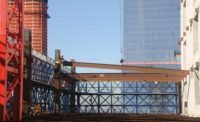A crane accident on a multistory residential project in the New York City borough of Queens left two men dead on November 22.
According to the New York City Dept. of Buildings, a 6,500-lb steel beam broke or fell out of its rigging after construction worker Elizandro Ramos, 43, stepped onto it. The falling beam struck the cab of the crane operator, George Smith, 47, killing both men.
Investigators do not consider the day’s strong winds to have been a factor in the accident, according to Buildings Dept. commissioner Rick Chandler. High winds have been a focus of crane-safety initiatives in New York City. A crane collapse in Manhattan’s Tribeca neighborhood on Feb. 5, 2016 that killed a pedestrian was attributed to failure to secure the crane's boom during high winds.
The crane in the Queens incident belongs to Staten Island, N.Y.-based crane and rigging company Crane Express. A representative of Crane Express declined to comment on the incident.
The construction site has been shut down as Building Department inspectors declared the owners had failed to provide adequate fall protection for workers.
Gary LaBarbera, president of the Building and Trades Council of Greater New York, said in a press release that the “incident was preventable and underscores yet again the need for a greater emphasis on construction safety and proper workforce training by the City and real estate industry.”
LaBarbera also criticized the non-union sector, which includes Crane Express. “In the last two years alone there have been 28 fatalities at construction sites in New York City with 85 percent of those incidents on non-union sites,” he said. “We can no longer tolerate the non-union sector putting profits ahead of the safety of workers, and this must end immediately.”
Crane safety has been a contentious topic in New York City in 2016. Mayor Bill de Blasio called for updating crane regulations in the city following the February fatality, and established the Crane Technical Working Group to provide recommendations. The group’s report was submitted in June, and included calls for increased use of data-logging systems on cranes to aid investigations, more training for operators, and limits on crane usage during wind speeds exceeding 30 mph.
The report prompted a lawsuit in October by a group of New York City contractor associations against the Buildings Dept., asserting that the wind-speed regulations do not take into account the load charts of different types of cranes.





Post a comment to this article
Report Abusive Comment